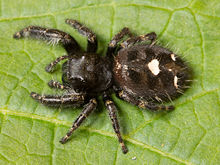Phidippus audax
| Phidippus audax | ||||||||||||
|---|---|---|---|---|---|---|---|---|---|---|---|---|

Phidippus audax |
||||||||||||
| Systematics | ||||||||||||
|
||||||||||||
| Scientific name | ||||||||||||
| Phidippus audax | ||||||||||||
| ( Hentz , 1845) |
Phidippus audax is the family of the jumping spiders belonging (Salticidae) spider. It occurs almost everywhere in North America and is the most common type of its genus, which is common throughout America; she was introduced to Hawaii.
features
Phidippus audax is a rather compact black spider up to 13 millimeters in size with two white oval spots on the side and a white triangle in the middle on the abdomen . There are also four pairs of black spots. The species is similar to Phidippus otiosus and Phidippus regius . Phidippus otiosus does not have oval but square spots on the back. Phidippus regius has no pairs of black spots on the abdomen.
The male is slightly smaller than the female, but the triangle on the opisthosoma is slightly larger. In younger spiders, the spots are still red, orange or yellow. On the chelicerae (jaw claws) they usually shimmer green.
Like all jumping spiders, they can see well with their very large front, dark blue shimmering central eyes. Not only movements are precisely perceived and tracked, they are also able to perceive their environment within a radius of 25 to 30 centimeters in sharp shapes and probably not only recognize their prey and attackers, but also their sexual partners. They build a nest of silk thread and never stray very far from it.
Their temperament varies from individual to individual, so some are livelier than others. They run a lot and hide again, but if they feel cornered, they raise their two front legs to impress the attacker with their size. If the approach continues, they will jump in defense and bite. However, they are very fast spiders who are always looking for a way to avoid the attacker without a fight.
nutrition
Phidippus audax can target its prey from afar and deliberately jumps several centimeters to catch it. Prey animals are mostly insects , such as crickets , which are larger than themselves. They often invade buildings to look for insects. In the case of insects, the poison is very quick and deadly.
attitude
Like is Phidippus audax also kept in terrariums. Although they are small animals, they prefer a slightly larger terrarium. They also need a little more space to jump. You need normal humidity and room temperature. Their poison is not strong enough to be dangerous to a person (unless one is allergic to it). Nor are they in any way biting or aggressive if not cornered or picked up. However, it is very difficult for this little spider to penetrate human skin with its chelicerae.
literature
- GB Edwards: Revision of the jumping spider genus Phidippus (Araneae: Salticidae). in vol. 11 Occasional papers of the Florida State Collection of Arthropods. Gainesville 2004. ISSN 0885-5943
Web links
Phidippus audax in the World Spider Catalog
Individual evidence
- ^ Norman I. Platnick: The World Spider Catalog , Version 7.5, 2007, American Museum of Natural History.
- ↑ regal jumping spider, Phidippus regius CL Koch (Arachnida: Araneae: Salticidae). University of Florida Institute of Food and Agricultural Sciences. Retrieved May 21, 2012
- ↑ Willis John Gertsch : American Spiders. van Nostrand Reinhold, New York 1979. ISBN 0-442-22649-7


